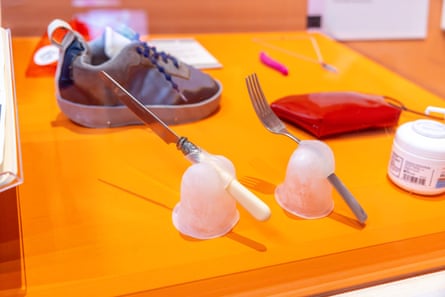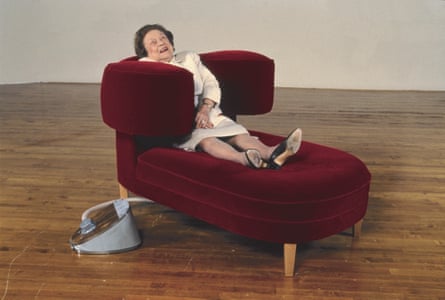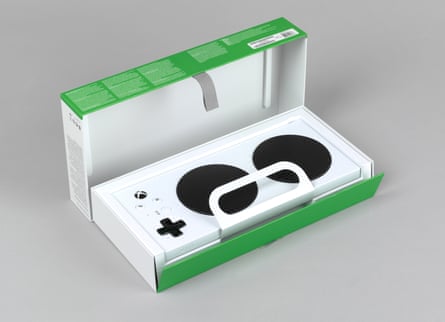Running through each section of this tremendous show is something mainstream society doesn’t get to see very often: disabled joy. It’s there in the harness that allows deaf and hearing-impaired gig-goers to feel music as vibrations on their chest. It’s there in the vibrant clothes. It’s there – certainly – in the all-purpose hands-free vibrator (yes, really). But it’s not just the individual items that exude this joy. It’s the themes of community action and care that show up again and again, and the reframing of the very concept of disability – from the “medical problem” society sees to the proud identity we know it to be.
This show, which takes a wide-ranging look at how disabled people have fashioned the world to better represent ourselves and better suit our needs, is divided into three parts: Visibility, Tools and Living. In Visibility, we see the evolution of accessible fashion from sterile to cool, and how disabled people have used photography to reclaim our images and bodies. In Tools, we see how disabled people have adapted everything from kitchen utensils to computers to allow us to get things done. And in Living, we see how we have demanded cultural and architectural change so that we can participate in society as equals.

The exhibition does a great job of including the full range of impairments disabled people have. There’s a bike with a built-in leg brace and a video explaining the concept of deaf space (an architectural idea about how spaces can be designed to support lip-reading and the use of BSL). There’s a self-tightening shoe and the original fidget-spinner, designed to help autistic and other neurodivergent people.
In this way, the exhibition goes far beyond the tired assumption that access means a ramp. It is also great to see disability-led design from all areas of life – not just care and housing, but also gaming, socialising, working, travelling, urban-planning and more. So often disability is treated as a monolithic experience, but the V&A is showing it in all its diverse, multifaceted glory.
The exhibition also has a deliberate focus on design not only for disabled people but by disabled people. In a world in which people often make assumptions about our needs, and presume to speak on our behalf, this is very welcome. Many of the projects and products featured are DIY inventions, moulded out of necessity by disabled people who weren’t able to buy the tools they needed. Others are the work of grassroots organising groups, or individual disabled people leveraging their jobs at big companies to create change.

Taken together, these items and their stories serve as a powerful reminder of disabled people’s often-overlooked agency, and a refutation of the idea that we are merely the recipients of help. We can and do help ourselves. As Tristram Hunt, the former Labour MP who is now the V&A’s director, emphasised at the exhibition’s launch, the idea is for it to embody the famous disability rights slogan: “Nothing about us without us.” It truly does.
This slogan applies politically as well as culturally. And what I like most about the exhibition is that it does not shy away from the inherently political nature of disability. Many objects on display are directly linked to the long fight for disability rights: one of the first things you see is a T-shirt emblazoned with the “Piss on Pity” slogan from the 1990 Block Telethon campaign. There are photos of disabled people stopping buses during the Campaign for Accessible Transport, as well as pieces related to the more recent (and ongoing) cuts to disability benefits.

But beyond referencing these discrete historical events, the exhibition also recognises that existing, thriving and finding joy as a disabled person in an ableist world is a political – often radical – act. That radicalism is reinforced by the show’s emphasis on the intersection between disability and other marginalised identities, with pieces linked to the Black Panthers and queer culture. This will feel intimately familiar to many disabled visitors, for whom it will be lovely to see their lived experiences reflected at a prestigious arts institution, but will hopefully provide a new perspective for nondisabled viewers, many of whom will never have seen disability and disabled lives presented in this way.
That’s what makes Design and Disability so good. It takes what disabled people know to be true – that we are creative, that we are innovators, that our exclusion comes from a world not built for us, that our lives are political – and makes those ideas interesting and accessible for everyone. Disability culture is vibrant and fun, boundary-breaking and world-shaping. So is this exhibition.

 3 months ago
117
3 months ago
117

















































